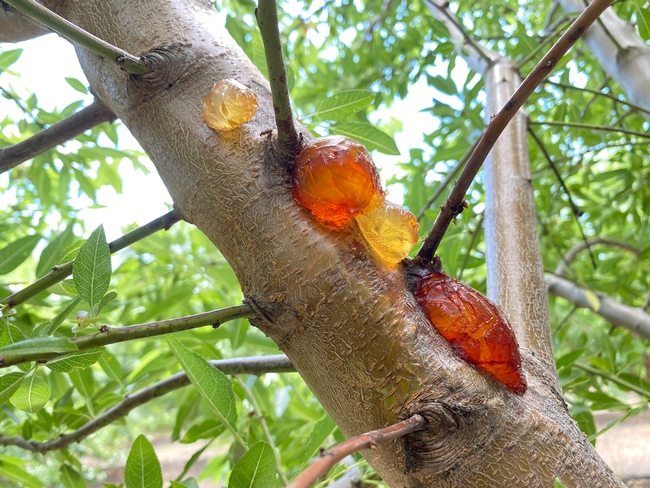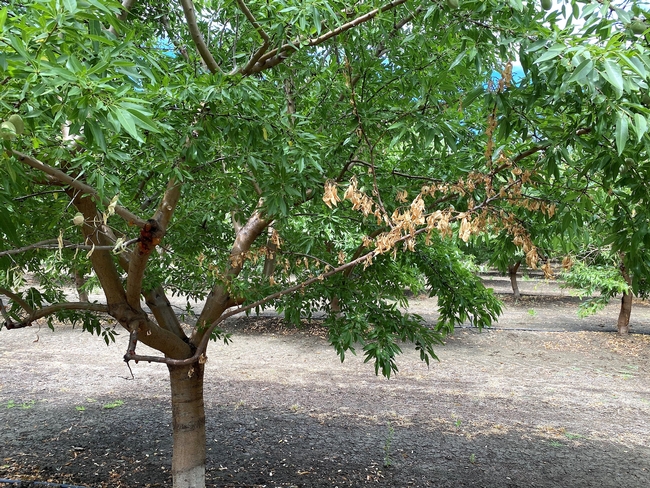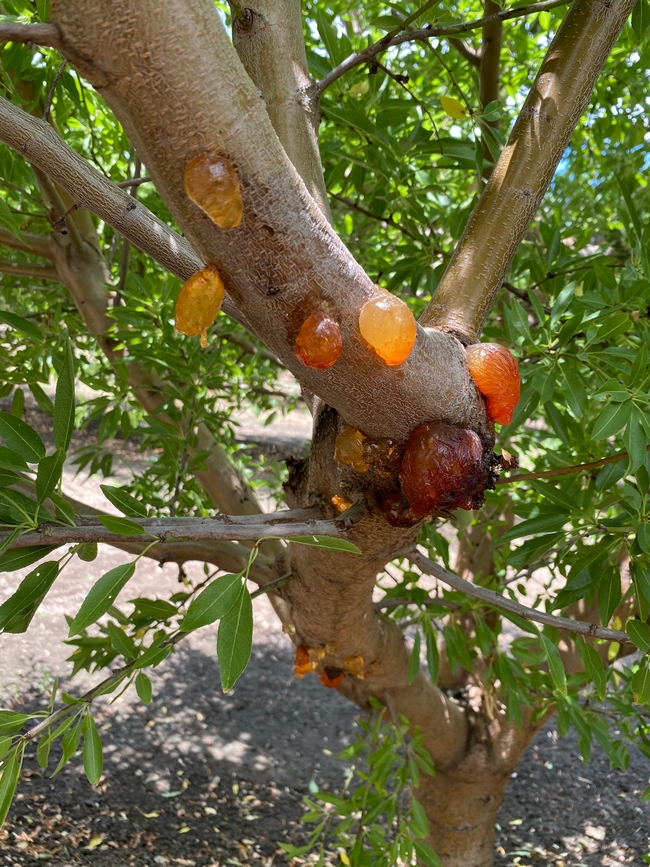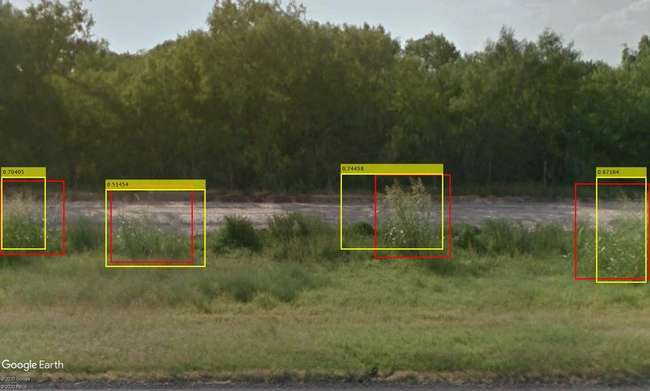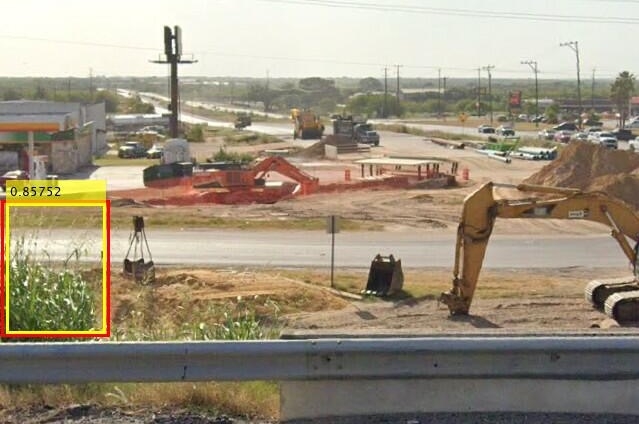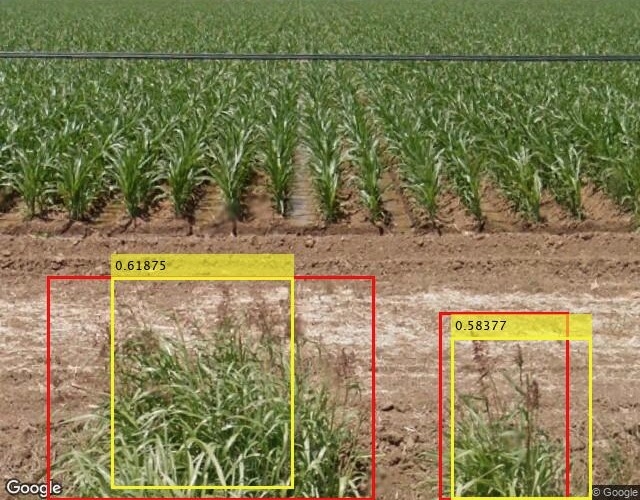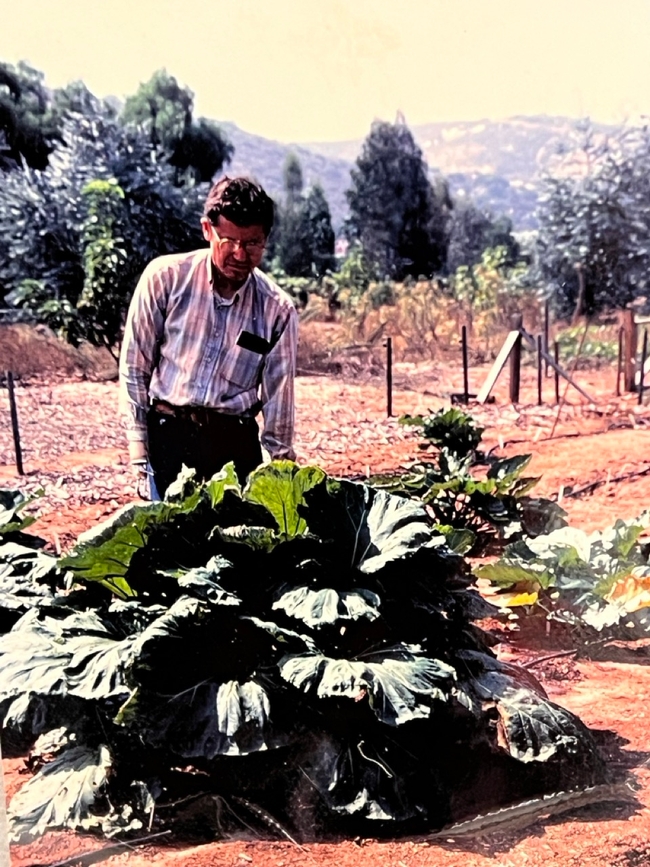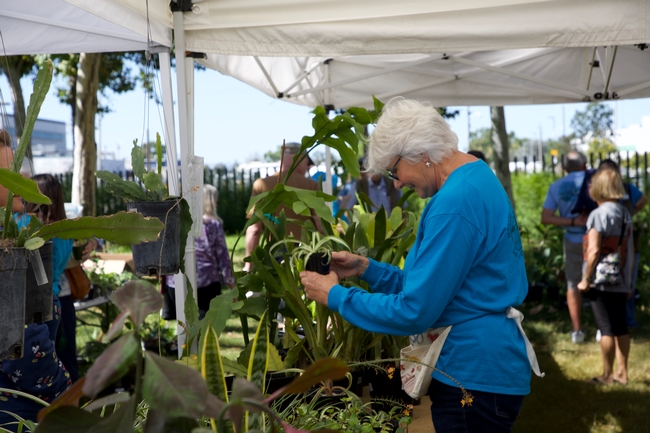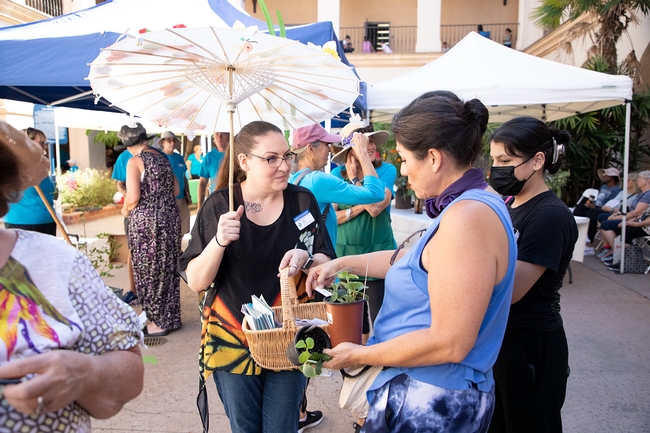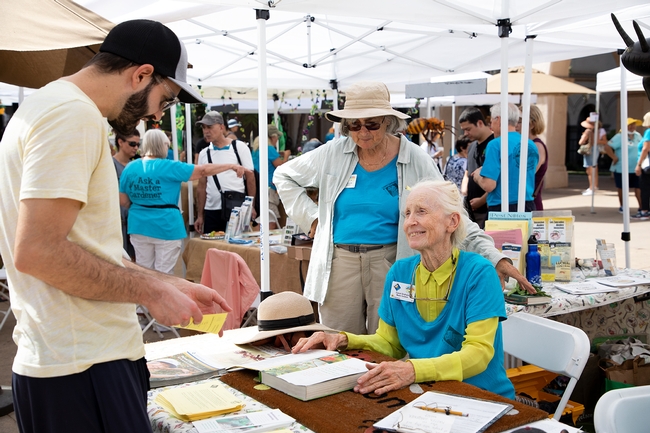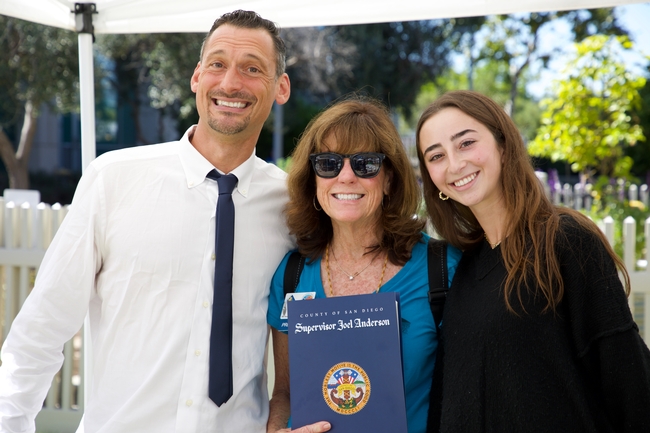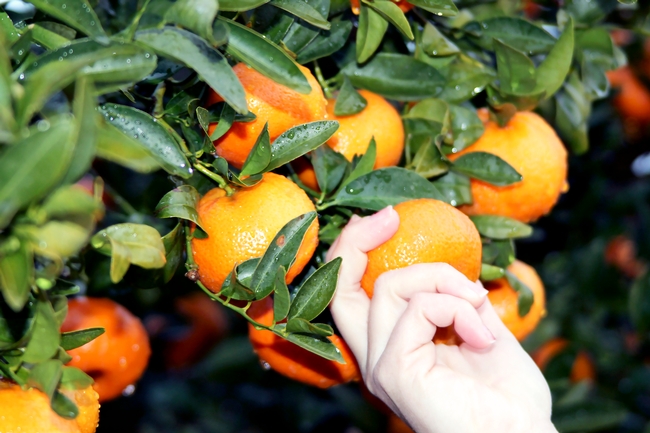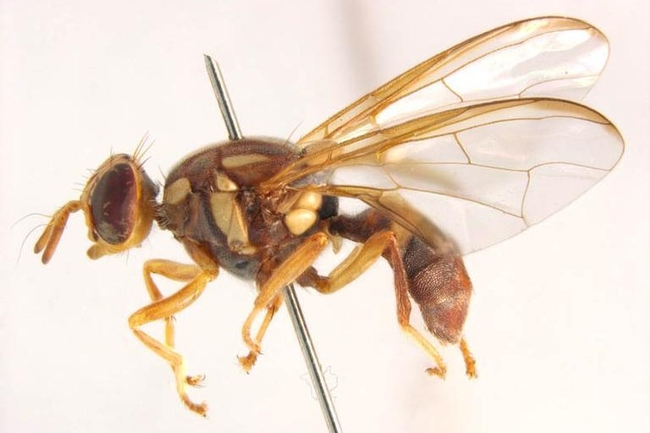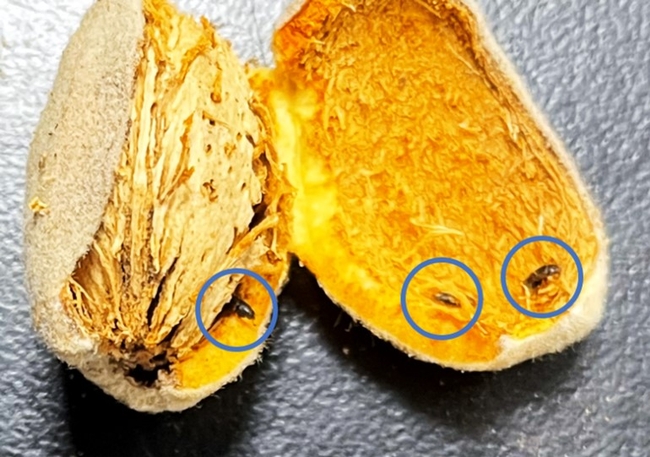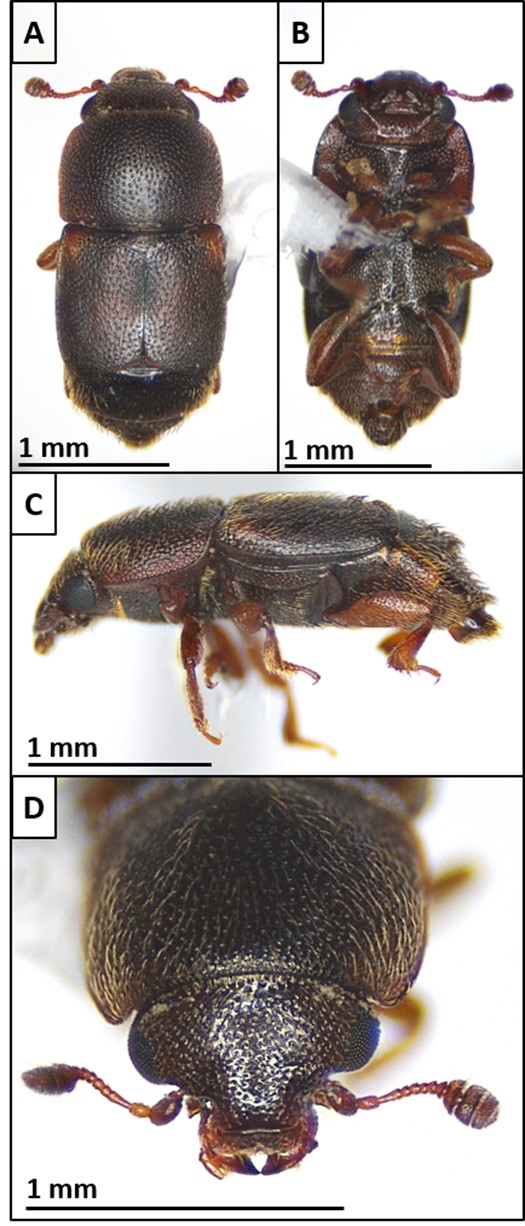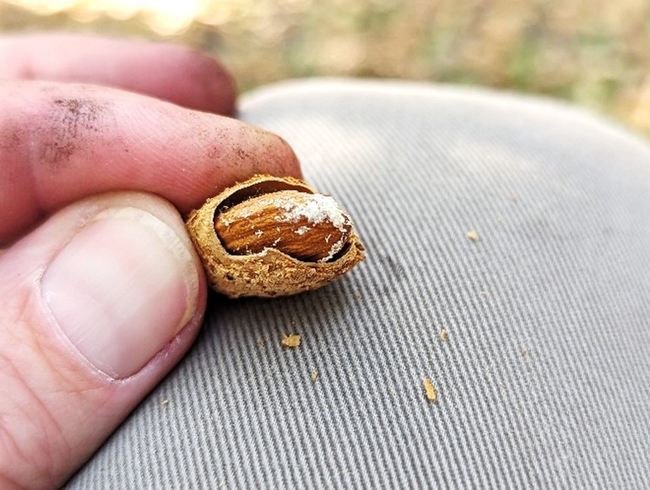Posts Tagged: pest
Almond growers should prepare for possibility of unusual disease outbreak
Wet winter, El Niño create favorable conditions for aerial Phytophthora pathogen
With heavy rains in the forecast amid strengthening El Niño conditions, almond growers should be on the lookout for a rare disease that can cause severe damage to their orchards, according to Florent Trouillas, a University of California Cooperative Extension specialist in fruit and nut pathology.
Phytophthora, soilborne microorganisms dubbed “water molds” because of their dependence on water, typically cause root and crown rot at the base of trees. But a few aerial Phytophthora can travel upwards and infect the higher parts of the tree. One species – Phytophthora syringae – is drawing special attention due to an unprecedented outbreak last winter, fueled by the atmospheric rivers that lashed California.
“It was found statewide – meaning in every almond-producing county – and disease incidence in orchards ranged from 10% of the trees infected to 75%,” said Trouillas, a UC Davis plant pathologist whose lab is based at UC Agriculture and Natural Resources' Kearney Agricultural Research and Extension Center in Parlier.
Trouillas and his colleagues, UC Davis graduate student Alejandro Hernandez and UC Riverside plant pathology professor Jim Adaskaveg, recently published a detailed online article describing the pathogen, which can infect a range of crops but mainly impacts almonds in California.
Although it doesn't kill the tree, the disease causes branch dieback that requires significant additional work and expense for almond growers. In 2022, almonds were the state's fourth-highest valued commodity, at $3.52 billion.
During last year's aerial Phytophthora outbreak, researchers also observed a new and troubling phenomenon: P. syringae, historically known to attack the cuts caused by pruning, was directly infecting the young shoots on almond trees – without any wounds.
“This was really the first time we had seen widespread evidence of infection on the twigs,” Trouillas said.
Although generally rare, outbreaks of P. syringae have been traditionally associated with wet El Niño years, according to Trouillas – and recent and persistent rain across the state should have growers on high alert.
Prune in dry weather, monitor, mitigate if necessary
While almond growers tend to prune during the downtime of winter, they should keep an eye on the forecast and aim for a 10- to 14-day window of dry weather to perform those tasks, whether training young trees or maintaining the established ones.
“If growers were to prune around a rain event – before, during or shortly after – this increases the likelihood of infection because this pathogen moves around with water,” Trouillas explained.
Researchers speculate that P. syringae, normally found in the soil, gets carried into the upper parts of a tree through strong winds and heavy rain. Alternatively, harvest processes like shaking and sweeping also produce air movements that may blow the microorganism into the canopy, where it waits for a favorable wet environment. The pathogen then attacks the wounds or young shoots, producing characteristic cankers and gumming.
The patterns and colors of the gum balls are keys to diagnosing an infection of this particular aerial Phytophthora. Starting around bloom time (mid-February), growers should monitor pruning wounds and young shoots on their trees, especially in the canopy, for signs of the disease.
The unique coloration of the gum balls – ranging from gold and amber to dark burgundy to bright red (see photos) – generally indicates P. syringae infection. But growers are urged to contact their local Cooperative Extension advisor for confirmation.
“It is super critical for growers that, whenever they see gumming, not to assume that it is this aerial phytophthora, because there are many other diseases that can cause gumming on the tree,” Trouillas said.
If the diagnosis is confirmed, growers may apply a compound that can mitigate the infection. The plant pathologists' recent writeup describes several curative treatment options, as well as a preventive measure that reduces the amount of pathogen in the soil and thus the likelihood of infection.
For more information on the pathogen's history and biology, as well as various options for disease management, visit the article on Sacramento Valley Orchard Source: https://www.sacvalleyorchards.com/almonds/trunk-soil-diseases/aerial-phytophthora-outbreaks-in-wet-years.
Google Weed View? Professor trains computer to spot invasive weed
Algorithm for AI enables low-cost tracking of invasive plant
To manage johnsongrass, a noxious weed that crowds out cotton and sickens horses, farmers have tried herbicides, burning and hand-pulling. Now, researchers at University of California, Davis, have developed a more high-tech weapon against the invasive weed: artificial intelligence and machine learning.
Using photos from Google's Street View database, UC Davis researchers have tracked down over 2,000 cases of johnsongrass in the Western United States for a fraction of the cost and time that it would take to do drive-by or other in-person surveys. They call their tool Google Weed View.
The advancement could help land managers easily and quickly survey for other problem plants.
“Once the model is trained, you can just go and run it on millions of images from Google Street View,” said Mohsen Mesgaran, an assistant professor in the Department of Plant Sciences at UC Davis. “We have huge flexibility, and its capability can be scaled up very quickly.”
The technique can easily be extended to other plant species. All that is needed is to label the new item in Street View photos and train the algorithm to identify that object in the images.
By providing location information, Google Weed View also offers an opportunity to examine how climate affects the growth and spread of weeds and invasive plants at very large scales.
“I think it can be both useful for management and for people with interests in more basic questions in ecology,” Mesgaran said.
A colleague's query
Mesgaran began looking at using Google's photo database of roadways, streets and highways after Kassim Al-Khatib, a professor of Cooperative Extension in the same department, asked if he could survey Western states for johnsongrass.
Al-Khatib studies where johnsongrass grows, ways to manage it and how this perennial has evolved to be so prevalent and resilient. He's also working with scientists at the University of Georgia to decode the genome of johnsongrass, which is one of the top 10 most invasive weeds worldwide.
Johnsongrass can crowd out native plants, harbor pathogens and affect agriculture. It grows up to 7 feet tall with flowers that are green, violet, dark red or purplish brown depending on maturity, according to a UC Statewide Integrated Pest Management Program briefing page.
“Johnsongrass is a major weed not just in California but worldwide,” Al-Khatib said. “It's very difficult to control. It's a problem on vineyards. It's a problem for cultivated crops. It's a problem on orchards.”
Google Weed View allows for rapid, convenient scanning. It is continuously updated via everyday users with compatible cameras and images collected by Google. “Instead of a day of in-person driving, we can use AI to determine if johnsongrass is in a county or not,” Al-Khatib said.
Setting the parameters
To find the weeds, Mesgaran went to Google Street View, which hosts billions of panoramic photos. It didn't take long to find johnsongrass.
“The pictures are really good quality,” he said. “You can see plants and flowers.”
Street View's photos offer a 360-degree view, so in his request Mesgaran set parameters, based on street direction (bearing), to only see the side view. He also specified latitude and longitude, and other factors. To train the deep, or machine learning model, he chose Texas, where johnsongrass is prevalent.
A student sorted through over 20,000 images from that request to find pictures with johnsongrass and drew rectangular shapes around the weeds. They located 1,000 images.
The labeled photos were fed into a computer to train a deep learning algorithm capable of identifying johnsongrass in Google's images. The model was run again to capture potentially more images containing johnsongrass. These additional images were then labeled and used to further refine the model. With each iteration, the algorithm learned and became more accurate.
“This deep learning model was trained by these images,” Mesgaran said. “Once we had a semi-working model, we ran it against about 300,000 images.”
For Al-Khatib's request, researchers focused on 84,000 miles of main roads in California, Nevada, Oregon and Washington states. The team discovered 2,000 locations with johnsongrass.
Google Weed View cost less than $2,000 to purchase the images and teach the model. A traditional car survey to cover the same area would cost an estimated $40,000 in gas, hotel, food and other costs.
“In a matter of months, we came up with 2,000 records and I can do it for the whole U.S.,” Mesgaran said.
Next up? The entire United States.
This story was originally published on the UC Davis College of Agricultural and Environmental Sciences news site.
UC Master Gardeners of San Diego celebrates 40 years of service to community
For 40 years, the University of California Master Gardener Program of San Diego County has upheld its mission of providing research-based information about home horticulture and pest management to the public, while earning and sustaining the community's trust in doing so.
“People trust UC Master Gardeners to provide accurate advice on gardening because they are trained by UC ANR [UC Agriculture and Natural Resources],” said Vincent Lazaneo, emeritus urban horticulture advisor and the first UC Master Gardener program coordinator for San Diego County.
The UC Master Gardener program, a public service and outreach program under UC ANR, is administered by local UC Cooperative Extension offices and outreach is provided by trained volunteers. In 1983, the UC Master Gardener program of San Diego County started with about 30 volunteers. Today, more than 350 volunteers serve the program, which is now managed by program coordinator Leah Taylor.
In San Diego, UC Master Gardeners have had a significant presence in schools, where they encourage an appreciation for plants and our planet; at the county fair where they field hundreds of questions related to plant care; and in community spaces such as Balboa Park and the Carlsbad Flower Fields where they staff demonstration gardens.
“Having the UC behind us is huge,” said Anne Perreira, UC Master Gardener and current president of the Master Gardener Association of San Diego County. “It opens doors for us and gives us credibility.”
'Dual citizenship' status expands capacity for support
When Lazaneo started the UC Master Gardener program in 1983, he felt the need to establish a formal association or 501(c)(3) nonprofit organization that would support the program.
Unsure of what the future held, Lazaneo believed that nonprofit status would increase the UC Master Gardeners' flexibility regarding project development, community engagement and financial planning. After 10 years, the UC Master Gardeners of San Diego County were approved as a registered nonprofit organization and became simultaneously known as the Master Gardener Association of San Diego County.
“It can be confusing for people when they hear that we're a UC program and an association,” explained Taylor. “It's like ‘dual citizenship' in a way, and I think the most important thing to know is that our status as a nonprofit and affiliation to UC work in conjunction to not only support the UC Master Gardeners and what they do in San Diego, but their ability to support UC Master Gardener programs in other counties.”
Emphasizing the research-based approach
Taylor, who has been the program coordinator since 2021, said that the UC Master Gardener program is instrumental in extending the work of UCCE advisors. “If you're working on research and you need to get that information out into the public, we've got 350 UC Master Gardeners who are trained and available to communicate on your behalf,” Taylor said.
“For me it's like a multiplier effect: how many San Diegans can I reach by teaching a seminar on small-scale hydroponics? Maybe 20 or 30,” said Gerry Spinelli, UC Cooperative Extension production horticulture advisor for San Diego County. “But how many can I reach by training 20 or 30 UC Master Gardener volunteers on the same topic? Maybe 200 or 300.”
Spinelli, who also advises the UC Master Gardeners for San Diego County, said that the group has been instrumental in data collection and disseminating information to the public, particularly in urban underserved areas.
Lazaneo recalls the UC Master Gardeners establishing a partnership in 1983 with Cuyamaca College in El Cajon. The college's Horticulture Department allowed the UC Master Gardeners to develop a research garden on campus. After setting a perimeter, building a fence, installing irrigation lines and rototilling the soil, the UC Master Gardeners planted different tomato varieties that were used in a statewide study assessing plant performance for home gardens.
In addition to educating and equipping the public, the UC Master Gardeners of San Diego County have contributed to research efforts on specific crops, including the development of a new artichoke variety, Imperial Star, with guidance from Wayne Schrader, former UCCE vegetable crops advisor for San Diego County.
The research garden, which was used for more than a decade, also aided in research efforts evaluating asparagus varieties, horned cucumbers called “Kiwano,” a fruit similar to melon called pepino dulce, sweet peas, rhubarb and many others. Similarly, the research garden has contributed to trials for soil solarization and chemical treatment to control root knot nematodes and expanded understanding of powdery mildew's impact on summer squash.
Evolving with the times
Out of 170 applications, Lazaneo selected about 30 individuals to be a part of the first class of UC Master Gardeners for San Diego County. Carol Graham, who is still active today, was in the original cohort that formed in 1983.
Graham said that “times have certainly changed,” and one of the changes she's noticed since joining UC Master Gardeners is the proliferation of insects. “I don't remember pests being a severe issue when I first started. Now, you've got all kinds of bugs that have moved into the county, causing people to overuse and misuse pesticides,” said Graham.
Graham's 40 years as a UC Master Gardener have given her an opportunity to teach people how to overcome their phobias of bugs and how to use pesticides safely and appropriately. Furthermore, her role as a UC Master Gardener has allowed her to teach others how to grow their own food in hopes of enhancing food security in the county, something she cares deeply about.
The UC Master Gardeners also have changed the way they communicate over the years. DeLayne Harmon, vice president of member services, is well-versed in the program's history.
“Before we began tracking our volunteer hours online, do you know what the UC Master Gardeners did back in the day?” asked Harmon, who joined UC Master Gardeners in 2020. “They wrote everything down by hand, with pen and paper!”
“It's easy to have the mentality that's like, ‘This is how we've always done things,'” said Harmon. “But the UC Master Gardeners know that there is always room for improvement, and we welcome opportunities to be better.”
Giving back and putting people first
The UC Master Gardeners of San Diego County are eager to improve access to fresh food in schools. Recently, the UC Master Gardeners were given a $5,000 grant by the Sage Garden Project, which will be used to partner with schools in under-resourced communities.
“We want to be in places where the people don't know about UC Master Gardeners,” said Perreira, the association president. “We realized that there are a lot of students who don't know what fresh food looks like and we want to change that.”
In 2022, the UC Master Gardeners transformed a landfill into a demonstration garden, now called the Paradise Hills Native Garden, which they also maintain. “It's beautiful and there are walking trails for the community to enjoy,” Taylor said. “The native garden is in a neighborhood that doesn't have a lot of green space, and to have something so beautiful, that encourages community gatherings, it's a good thing.”
Looking to the future of the UC Master Gardener program in San Diego, Taylor says that she wants to continue making an impact in the community and having the UC Master Gardeners be that driving force.
Grateful for Taylor's leadership, Spinelli said that he is excited about the program's impact on food education, particularly in food deserts.
“We are blessed with a climate that allows year-round food production, and with the science-based knowledge offered by the UC system, our UC Master Gardeners can provide San Diego County residents with the tools to grow local, healthy, nutritious, safe and environmentally friendly food for their families,” Spinelli said.
When reflecting on how far the UC Master Gardeners of San Diego County have come, Perreira – who has been a UC Master Gardener since 2016 – emphasized how important it is to continue their legacy of doing good in and with the community. “We've got a diversity of skills within our group and I'm ready for us to expand our capacity to create change. What we do and what we say have to mean something!” she said.
First-ever Queensland fruit fly quarantine restricts moving homegrown produce
QFF quarantine in LA, Ventura counties among seven fruit fly quarantines statewide
Residents in multiple Southern California and Northern California counties should not move homegrown fruits and vegetables from their properties to help contain several species of fruit fly that can destroy crops and impact the livelihoods of local farmers.
With sharing and gifting of food integral to the holiday season, the California Department of Food and Agriculture is reminding people to heed the seven active fruit fly quarantines aimed at controlling the Mediterranean fruit fly, Oriental fruit fly, Tau fly and Queensland fruit fly. The links below describe quarantine zone boundaries:
- Mediterranean fruit fly: Los Angeles County, Leimert Park Area
- Oriental fruit fly: San Bernardino and Riverside Counties, Redlands and Yucaipa Areas
- Oriental fruit fly: Sacramento County, Rancho Cordova Area
- Oriental fruit fly: Contra Costa County, Brentwood Area
- Oriental fruit fly: Santa Clara County, Santa Clara Area
- Tau fly: Los Angeles County – Stevenson Ranch, Valencia, Santa Clarita Areas
- Queensland fruit fly: Ventura and Los Angeles Counties, Thousand Oaks Area
People within these zones should consume or process (i.e., juice, freeze or cook) their homegrown fruits and vegetables at the place of origin and not move them off their property. Uneaten produce should be double-bagged in plastic bags and disposed of in the landfill bin – not compost or green waste.
Queensland fruit fly threatens California citrus, other crops
The Queensland fruit fly (Bactrocera tryoni) quarantine is the first of its kind in the U.S. Although QFF was first seen in California in 1985, the recent detection of two adult males triggered the unprecedented quarantine action by USDA's Animal and Plant Health Inspection Service and CDFA.
“This pest has earned a bad reputation for wreaking havoc on fruit production in Australia, where it is native,” said Hamutahl Cohen, University of California Cooperative Extension entomology advisor for Ventura County. “Adult flies lay their eggs in fruit, and the eggs hatch into larvae that then feed on the fruit, causing damage.”
And while females of other fruit fly species live for only two or three months, QFF females are unique in that they can live up to a year, according to Cohen.
“Once QFF populations take root, they're challenging to manage because females can each lay up to 100 eggs per day,” Cohen said.
In addition to being highly adaptable to a variety of environmental conditions, QFF has more than 170 host plants – including a wide range of California commodities such as citrus, grape, strawberry, fig, avocado, apricot, peach, cherry, nectarine, plum, pear, apple, tomato and sweet pepper.
The threat to citrus is especially concerning, as Southern California growers continue to grapple with the specter of spreading huanglongbing (HLB) disease, which kills citrus trees. Cohen said residents of citrus-growing regions can do their part to help their neighbors and local economy by respecting quarantine restrictions.
“Growers are already dealing with other invasive species like Asian citrus psyllid [vector of HLB pathogen], so we as homeowners need to prevent the spread of fruit flies to reduce the burden on them,” she explained.
While a spike this year in the detections of multiple fruit fly species was likely caused by a host of factors, Cohen speculates that increased post-pandemic travel is helping to move the flies. And with holiday travel in full swing, she said it's important to practice “Don't Pack a Pest” principles.
“Invasive species often hitchhike on fruits and vegetables brought into California by travelers – that's why we often first find invasive species in urban and suburban backyards, and not on farms,” Cohen said. “Travelers entering the U.S. can visit dontpackapest.com to learn about which products they can and cannot bring back with them.”
To report a suspected infestation of fruit fly larvae in homegrown produce, call the CDFA pest hotline at 1-800-491-1899. Growers with questions and concerns are urged to contact their local agricultural commissioner's office.
New pest infesting almonds and pistachios in the San Joaquin Valley
Crop sanitation will be key to controlling the invasive carpophilus beetle
Growers and pest control advisers (PCAs) should be on the lookout for a new pest called carpophilus beetle (Carpophilus truncatus). This pest was recently found infesting almonds and pistachios in the San Joaquin Valley, and is recognized as one of the top two pests of almond production in Australia. Damage occurs when adults and larvae feed directly on the kernel, causing reductions in both yield and quality.
Populations of carpophilus beetle were first detected in September in almond and pistachio orchards by University of California Cooperative Extension Specialist Houston Wilson of UC Riverside's Department of Entomology. Pest identification was subsequently confirmed by the California Department of Food and Agriculture.
Wilson is now working with Jhalendra Rijal, UC integrated pest management advisor, North San Joaquin Valley; David Haviland, UCCE farm advisor, Kern County; and other UCCE farm advisors to conduct a broader survey of orchards throughout the San Joaquin Valley to determine the extent of the outbreak.
To date, almond or pistachio orchards infested by carpophilus beetle have been confirmed in Stanislaus, Merced, Madera and Kings counties, suggesting that the establishment of this new pest is already widespread. In fact, some specimens from Merced County were from collections that were made in 2022, suggesting that the pest has been present in the San Joaquin Valley for at least a year already.
“It has likely been here for a few years based on the damage we've seen," Rijal said.
This invasive beetle overwinters in remnant nuts (i.e. mummy nuts) that are left in the tree or on the ground following the previous year's harvest. Adults move onto new crop nuts around hull-split, where they deposit their eggs directly onto the nut. The larvae that emerge feed on the developing kernels, leaving the almond kernel packed with a fine powdery mix of nutmeat and frass that is sometimes accompanied by an oval-shaped tunnel.
Carpophilus beetle has been well-established in Australia for over 10 years, where it is considered a key pest of almonds. More recently, the beetle was reported from walnuts in Argentina and Italy as well. Carpophilus truncatus is a close relative to other beetles in the genus Carpophilus, such as the driedfruit beetle (C. hemipterus) that is known primarily as a postharvest pest of figs and raisins in California.
Monitoring for carpophilus beetle is currently limited to direct inspection of hull split nuts for the presence of feeding holes and/or larvae or adult beetles. A new pheromone lure that is being developed in Australia may soon provide a better monitoring tool for growers, PCAs and researchers.
“We're lucky to have colleagues abroad that have already been hammering away at this pest for almost a decade,” said Haviland. “Hopefully we can learn from their experiences and quickly get this new beetle under control.”
The ability to use insecticides to control carpophilus beetle remains unclear. The majority of the beetle's life cycle is spent protected inside the nut, with relatively short windows of opportunity available to attack the adults while they are exposed. The location of the beetles within the nut throughout most of their life cycle also allows them to avoid meaningful levels of biological control.
In the absence of clear chemical or biological control strategies, the most important tool for managing this beetle is crop sanitation.
“Given that this pest overwinters on remnant nuts, similar to navel orangeworm, crop sanitation will be fundamental to controlling it,” Wilson said. “If you needed another reason to clean up and destroy mummy nuts – this is it.”
In Australia, sanitation is currently the primary method for managing this pest. And here in California, new research and extension activities focused on carpophilus beetle are currently in the works.
“It's important that we get on top of this immediately,” said Wilson. “We're already starting to put together a game plan for research and extension in 2024 and beyond.”
If you suspect that you have this beetle in your orchard, please contact your local UC Cooperative Extension farm advisor (https://ucanr.edu/About/Locations/), County Agricultural Commissioner (https://cacasa.org/county/) and/or the CDFA Pest Hotline (https://www.cdfa.ca.gov/plant/reportapest/) at 1-800-491-1899.

